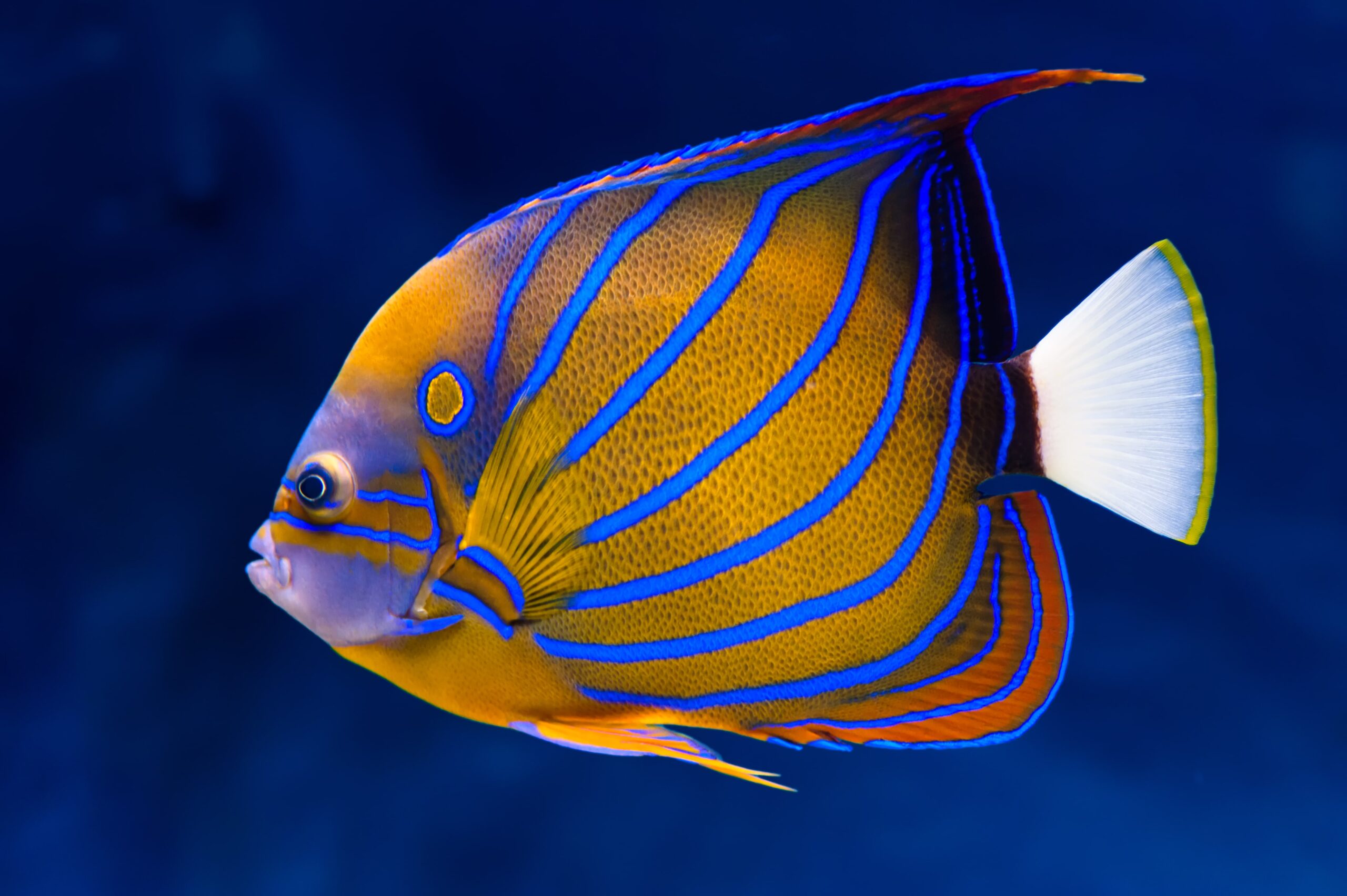
Majestic Angelfish Care Guide
Glossary:
- Care Guide & Requirements
- Reef Safe
- Prices
- Food & Diet
- Facts
- FAQs
- Tank Mates & Environment
The Majestic Angelfish, or Blue Girdled Angelfish, is one of the most popular species of angelfish. One of the main reasons for their popularity is their docile nature along with their colorful appearance. This species is part of the Pomacanthus family, which it shares with the Emperor and Blue Faced Angelfish. They’re found in many areas of the Indo-Pacific region.
Is the Majestic Angelfish reef safe?
The Majestic Angelfish is potentially reef safe if you take the right precautions. It often varies from fish to fish. While some might completely ignore the coral, other fish might nip at it to the point where they kill it.
The best way to gauge the fish’s aggressiveness toward coral is to observe it for a period after putting it in with a piece of coral. If it appears to be attacking the coral, it might be best to avoid keeping it in a tank with coral, in which case you may be able to transfer your corals to another tank.
What is the Majestic Angelfish lifespan?
Many researchers and divers have come across Majestic Angelfish in the wild that have lived for nearly two decades, but this may not be as easy to achieve in captivity. However, they can live for around this long with the proper care.
Majestic Angelfish food and diet
Majestic or Blue Girdled Angelfish tend to eat many types of natural foods. Some potential foods could include Mysis shrimp, spinach, marine algae, Spirulina, krill, tunicate and sponge colonies, and angelfish preparations.
If you experience difficulty feeding the Majestic Angelfish, try to introduce gut-loaded brine shrimp to the tank, which may inspire the fish’s appetite.
Majestic Angelfish FAQs
What is the Majestic Angelfish lifespan?
Many researchers and divers have come across Majestic Angelfish in the wild that have lived for nearly two decades, but this may not be as easy to achieve in captivity. However, they can live for around this long with the proper care.
What are the tank requirements for the Majestic Angelfish?
If you plan to keep a Majestic Angelfish in a saltwater aquarium, you will need a larger tank of at least 125 gallons. It should include plenty of spaces for the fish to hide, with coral or other features that can shelter the fish. You’ll also need to include live rock that can grow sponges and algae, which the fish will use for grazing.
Lighting should also be bright to protect the fish from head and lateral line erosion (HLLE). This lighting will also showcase the fish’s vibrant blue and yellow coloring.
Finally, water needs to be in the right condition to accommodate Majestic Angelfish. Make sure nitrate and nitrite levels are at a minimum, with less than 5 ppm of nitrates and 0 ppm of nitrites. Additionally, the temperature should be around 74 to 78 degrees Fahrenheit, while alkalinity should be around 8 to 11.5.
Are Majestic Angelfish hard to keep?
Majestic Angelfish are potentially challenging for aquarists because of their size, aggressive nature, and strict environmental requirements. You need to maintain the ideal environment for these fish, like other species of Angelfish, which also makes them more difficult to acclimate.
Majestic Angelfish price
Generally, the larger and more mature the Majestic Angelfish, the more it will cost. The price of a Majestic Angelfish juvenile tends to fall around $80 to $100, while larger fish can cost up to $400 or so. Many shops have detailed pricing based on the type of Majestic Angelfish you’re looking for, and you’ll often need to put yourself on a waiting list for one or more fish.
What are the tank requirements for the Majestic Angelfish?
If you plan to keep a Majestic Angelfish in a saltwater aquarium, you will need a larger tank of at least 125 gallons. It should include plenty of spaces for the fish to hide, with coral or other features that can shelter the fish. You’ll also need to include live rock that can grow sponges and algae, which the fish will use for grazing.
Lighting should also be bright to protect the fish from head and lateral line erosion (HLLE). This lighting will also showcase the fish’s vibrant blue and yellow coloring.
Finally, water needs to be in the right condition to accommodate Majestic Angelfish. Make sure nitrate and nitrite levels are at a minimum, with less than 5 ppm of nitrates and 0 ppm of nitrites. Additionally, the temperature should be around 74 to 78 degrees Fahrenheit, while alkalinity should be around 8 to 11.5.
Majestic Angelfish facts
The following are some interesting facts about the Majestic Angelfish:
- The Majestic Angelfish can grow up to 28 centimeters, or 11 inches.
- Wild Majestic Angelfish live in water as deep as 37 meters.
- As Majestic Angelfish mature, their blue and white coloring begins to change to yellow on the flanks, along with the dorsal and tail fins.
What other fish are the best tank mates for the Majestic Angelfish?
Certain semi-aggressive fish tend to fare well with the Majestic Angelfish. Some species that might do well include Clownfish, Tangs, and Wrasses. Generally, Majestic Angelfish aren’t aggressive toward other fish, although they may go after conspecifics and other large species of Angelfish. While you can have two Majestics of tthe opposite sex, it’s difficult to discern between males and females of this species.
When introducing new fish to your tank with the Majestic, it’s best to introduce all of the large fish at the same time. Otherwise, they may become territorial and attack or even kill each other.
Majestic Angelfish may provide more of a challenge for aquarists, but they’re generally inexpensive, relatively easy to maintain, and have beautiful coloration, making them one of the most enjoyable fish species to own.
Where to Buy Majestic Angelfish?
You can buy Majestic Angelfish from many fish stores. Some online options for buying Majestic Angelfish include:
Majestic Angelfish may provide more of a challenge for aquarists, but they’re generally inexpensive, relatively easy to maintain, and have beautiful coloration, making them one of the most enjoyable fish species to own.
